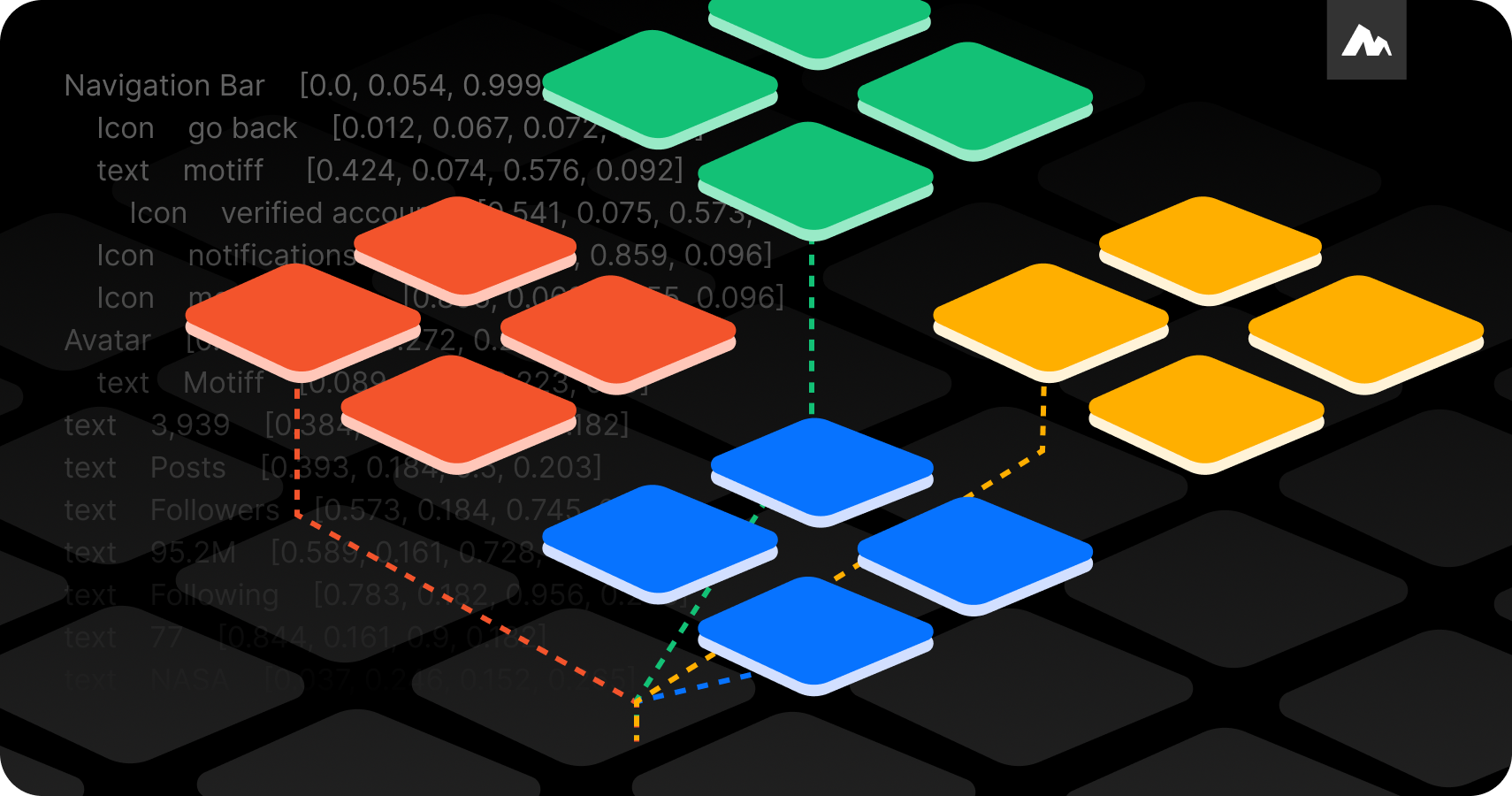
MLLM by Motiff: Shaping the future of UI design




Research on user needs and preferences is crucial. It plays a key role in the improving digital product world. UX designers must use the right tools to understand users and create intuitive applications.
User experience (UX) research looks at how people use products and services. It uses interviews, surveys, and tests to understand user behavior, motivation, and needs. Today, 82% of companies have at least one UX researcher. This shows how important UX is for making products.
Investing in UX design pays off big; every dollar spent can bring back about $100 (ROI = 9,900%). Centering design around users helps businesses a lot. It shows why focusing on the user is key in the design process. Most consumers, 94%, prefer easy-to-navigate designs, and 83% think it's important to keep UX designs fresh.
Tools in UX design are very important. They keep UX research organized and productive. They let designers get and use information.
In our digital age, a good user experience helps convert browsers into buyers. That’s why it’s essential to use the latest UX research tools.
Software companies spend 20% of their budget on UX design. This shows their dedication to improving it. By 2024, UI and UX design will be key in shaping how we interact with technology.
UX research and analytics tools are invaluable. They help us gain insights into user behavior, preferences, and pain points. They validate design decisions.
Also, they find areas to improve to ensure the end product fits the target audience. They range from user testing platforms to analytics software. They offer unique design features.
User interviews are the cornerstone of user research for many, especially in the early startup phase. When it comes to organizing user interviews, perfect scheduling is crucial. It's key for a productive, efficient process. In UX research, the utensils Zoom and Calendly are the best known for assisting in scheduling interviewees.
Calendly is the go-to tool for organizing these interviews. The new scheduler streamlines scheduling. It does this by integrating with your calendar. It also lets participants select their preferred slots easily.
Integrating Calendly with Typeform can streamline participant onboarding. It's clean, intuitive, and an all-around game-changer.
Zoom is a popular video conferencing software known for its user-friendly interface and stability. This tool allows UX designers to conduct virtual interviews with remote participants. The platform captures interactions with high immersion. They have high engagement through HD video and clear audio. The environment has become suitable for receiving user feedback, which is input.
Zoom lets designers record video interviews. They can review them later to fix errors or get more info. Accurate user comments are crucial for good design decisions. They require a unique quality of observation.
Calendly is a great tool. It can save a lot of time when scheduling interviews. It integrates Zoom links for easier interview scheduling and organization in the 'Events' section.
Besides, Calendly simplifies logistics communication. It lets designers focus on preparing questions and drawing viewpoints from discussions.
Also, Calendly offers more than just scheduling. It provides functions to enhance productivity for individuals and teams. Its scheduling feature gives businesses full control over managing leads. It also speeds up the deal-closing process.

In UX research, the synthesis phase turns raw data into useful insights. It also creates design solutions. Using advanced tools for repeated cuts reduces the amount of work. It lets design teams be more efficient, creative, and collaborative.
FigJam and Miro aim to achieve the same goal, located on top of the very convenient Google Sheets.
To process all the qualitative data you've gathered, I recommend FigJam, Figma's whiteboarding tool. It’s superb for workshops and research synthesis. But if FigJam doesn’t meet your needs, Miro is your next best bet. It's richer in features and integrations, offering flexibility to expand its functionality.
Figjam makes transitioning between Figma and whiteboarding a breeze. FigJam is a powerful tool that improves a UX designer's efficiency during synthesis. The platform has an easy-to-use interface. It has entertainment features. These features encourage participation and improve research.
The AI-powered features in FigJam automate boring tasks. This lets designers focus on new design ideas.

Miro has been around much longer and has more app integrations, allowing heavy customized jobs. Miro's usability needs to be clearer for users of the popular collaborative whiteboarding tool. Some people got confused at first. This made them spend more time learning to use the tool. After mastering it, Miro becomes a vast canvas. On it, you can visualize ideas and mix research findings.
Teams can easily access many whiteboard templates on this platform. They use them to organize their synthesis. Miro enables them to create a roadmap for their ideas, leading to increased collaboration on research findings.
The Miro platform has whiteboard templates for teams to analyze data and get insights. It helps visualize and understand complex information efficiently.
Both tools have their strengths, so choose the best fit your needs.

Google Sheets is still essential for organizing UX research findings, along with FigJam and Miro. This platform has a spreadsheet-based interface. It helps organize both qualitative and quantitative data from various research methods.
The tool shows live preview animations. It works well with other platforms. They help understand how users behave in real-time. This feature promotes transparency. It ensures that design groups use research results easily. It has excellent collaboration features, is simple to use, and best of all - it's free!
Screenapp is a tool. It uses AI to analyze user interviews and give helpful tips. It also allows for quick searches within transcripts.
Screenapp represents a paradigm shift in user testing and feedback collection. Its advanced capabilities automate parts of the design process. They greatly speed development while ensuring precise and accurate user interaction analysis. The tool shows live previews and animations and works well with other platforms to understand how users behave in real time.
Screenapp is a software platform that collects feedback and analyzes user interactions. The software streamlines the development process with real-time previews, animations, and platform integration.
Screenapp provides unmatched assets and templates. They are for popular screen sizes and work well with voice control. The tool makes researchers' work easier. It improves social media presence with analytics dashboards.

ChatGPT is a valuable tool for summarizing notes and overcoming creative blocks. You can use it to rephrase qualitative insights from users into actionable filters or features. It's an endless source of ideas when you are feeling stuck.
Among its skills is its ability to help analysts create survey questions defining users’ insight. ChatGPT can quickly draft research plans. It can also create catchy content using its language algorithms. One essential research skill is designing practical questionnaire questions to gather user insights.
Using ChatGPT's AI reduces UX designers' time and effort. It helps with research planning and implementation.

For those in larger teams, Dovetail's great platform stores, analyzes, and shares user research data. Its tagging system is helpful. It lets you easily aggregate specifics across sessions.
Dovetail excels at centralized storage, automated analysis, and easy collaboration. This makes it a top contender for enterprise teams. The tagging system helps compile insights from multiple sources quickly.

Accurate and efficient user feedback is critical to improving the user experience in UX research. UX designers can use SurveyMonkey and Typeform for reliable feedback.
SurveyMonkey provides smart data analysis tools. They help designers turn survey responses into useful insights. The platform has comprehensive analytics. They allow research on user feedback. This includes finding trends and highlighting preferences and issues. This approach to data analysis emphasizes evidence-based UX research. It values empirical data over subjective principles. It's for informed decision-making.
The crucial part of the iterative design is evaluating the feedback gained after surveys. SurveyMonkey is super helpful in that it has robust data analysis tools. Designers can break down survey responses level by level. They can get useful data that guides strategic design.
The reports provide detailed information about user feelings and preferences. They lead designers to follow an evidence-based user experience style.

Typefprm stands out. It has a customized client-oriented look and a participative atmosphere. This atmosphere motivates people to give elaborate information. The platform's form-building tool allows designers to create engaging and user-friendly surveys.
Research indicates that using Typeform increases response rates by an average of 15%. typeform offers an engaging way to gather feedback through its interactive forms. At the same time, Google Forms is a no-cost alternative. But, it could have more features.
You can use Typeform to create fun, dynamic surveys that adapt based on user responses. It also connects with Calendly to simplify participant onboarding. For a free option, Google Forms works but lacks Typefprm's gloss.

UX researchers and designers use various methods. They use interviews, surveys, testing, and data analysis to understand user behavior and needs. These insights guide the design process. They ensure the final product fits user expectations and preferences.
Also, ethics are crucial in UX design. They shape how users interact with technology. UX has significantly influenced digital product interaction. It underscores the balance between personalized experiences and user privacy.
Ethical considerations in UX design are crucial. They guide a path forward where digital products meet users' needs with integrity and respect for their privacy.
As the AI-powered professional UI design tool, Motiff AI offered the chance for collaboration between human and AI. The multiple functions of Motiff, for instance, the AI Design Systems, Motiff Lab, and AI Toolbox, are especially helpful. They are for UX researchers and designers.
AI Design Systems start your intelligent practices today. By revolutionizing the way your team creates and maintains design systems, ensureing cosistency of your design, the AI Design Systems help designers transfer from the collaboration era to the AI era.
Read our blog to figure out more details:
AI Design System Creator: A new practice in the AI era with just one click

With Motiff Lab, the future is right here. It's a place where humans and AI collaborate togehter.
Read our blog to figure out more details:
AI Magic Box: Drag a box for future

AI Toolbox, designers could achieve 10x efficiency and advanced experience with AI-powered UI tools.
Read our blog to figure out more details:
AI Reduplication: Fast duplicate, smart replace

With Motiff, the collaboration between human and AI has started. Designers could achieve great efficiency, start their intelligent practices, design, align and build their team by using Motiff, the future is right here.
As the AI-powered professional UI design tool, Motiff offers designers the ability to explore various AI functions for free, embarking on beginner adventures starting now!









